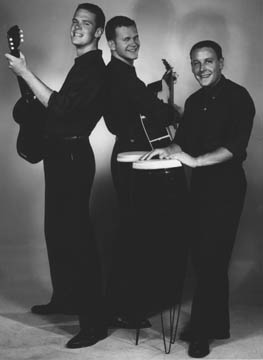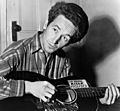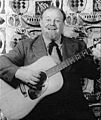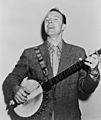American folk music revival facts for kids
The American folk music revival was a time when old American folk songs became popular again. This happened mostly from the 1940s to the mid-1960s. Before this, some folk singers like Woody Guthrie and Lead Belly were already known. But the revival brought many different styles of American folk music to a much bigger audience. These styles had influenced other music like country, blues, jazz, and rock and roll.
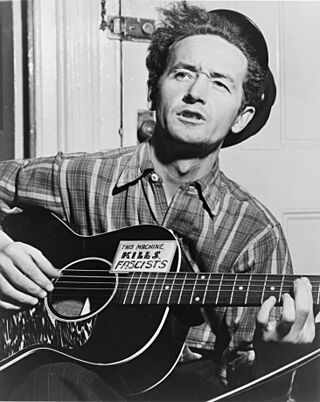
Contents
How the Folk Revival Began
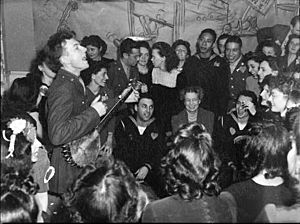
The First Steps
In the 1940s, people in New York City became very interested in folk dancing. This helped musicians like Pete Seeger become more known. The real start of the folk revival as a big, popular movement came with a group called The Weavers. They formed in 1948 with Pete Seeger, Lee Hays, Fred Hellerman, and Ronnie Gilbert.
Pete Seeger and Lee Hays had been in another group called the Almanac Singers. This group often included Woody Guthrie and Lead Belly. The Weavers had a huge hit song in 1950 called "Goodnight, Irene". It was number one on the music charts for 13 weeks! They had other popular songs too, like ""So Long It's Been Good to Know You"".
However, The Weavers faced problems because of their political beliefs. During a time when people were very worried about certain political ideas, Pete Seeger was listed as a possible threat. Radio stations stopped playing their songs, and concerts were canceled. Pete Seeger and Lee Hays even had to speak to a government committee. But in 1955, The Weavers had a very successful reunion concert. Their album from that concert became a top seller.
Folk Music Goes Underground
During the 1950s, folk music was often linked to political ideas that some people didn't like. So, it became less visible. Artists like Pete Seeger could only perform in schools and summer camps. Folk music became popular in places like New York's Greenwich Village and San Francisco's North Beach. It was also popular in college towns.
In the early and mid-1950s, folk songs were mostly heard in coffee houses, at parties, and at college concerts. Folk music started to mix with the "beatnik" scene, which was a group of artists and writers with a unique style. Singers traveled around the U.S. and Canada, performing in coffee houses. Two singers who became well-known during this time were Odetta and Harry Belafonte. They sang traditional blues and folk songs. Harry Belafonte had big hits with songs like "Scarlet Ribbons" and Jamaican calypso music.
The Revival Reaches Its Peak
The Kingston Trio was a group from the West Coast. They were inspired by The Weavers and sang many traditional songs. They avoided political songs and had a clean-cut, college-student image. Their first big hit was "Tom Dooley" in 1958. It sold over three million copies!
The Kingston Trio's success helped create a new Grammy Award category for folk music. They even had four albums in the top 10 at the same time in 1959. Their huge success encouraged record companies to sign more folk artists, including those with more traditional or political styles.
After The Kingston Trio, Joan Baez became very popular. Her first album in 1960 stayed on the charts for over two years. Joan Baez sang mostly traditional songs, but she was also openly political. As the Civil Rights Movement grew, she joined Pete Seeger and Woody Guthrie. Joan Baez sang "We Shall Overcome" at Martin Luther King Jr.'s 1963 March on Washington. Harry Belafonte and Odetta also performed there.
Songs played a very important role in the Civil Rights Movement. They helped people feel strong during protests for voting rights and equality. The peace movement also grew, protesting the arms race and the Vietnam War.
A young singer-songwriter named Bob Dylan signed with Columbia Records in 1961. His songs became very popular after Peter, Paul & Mary had a hit with his song "Blowin' in the Wind". This trio also made Pete Seeger's "If I Had a Hammer" famous across the country.
Soon, folk music included not just old traditional songs, but also new, personal songs written by performers. These artists were called "singer-songwriters." Because of the success of folk artists, record companies started to record a new generation of folk singers. These included Phil Ochs, Tom Paxton, Buffy Sainte-Marie, Judy Collins, and John Denver. Many of these singers learned old songs by listening to a famous collection called the Anthology of American Folk Music. Some of the older artists from these recordings were even "rediscovered" and performed at festivals.
Finding and Sharing Old Songs
In the 1950s, more and more folk music fans started buying records by older, traditional musicians. These musicians came from places like the Appalachian Mountains and big cities. New collections of old recordings from the 1920s and 1930s were released. Also, recordings made by people like John Lomax and Alan Lomax in the 1930s and 40s became more available.
In 1952, Folkways Records released the Anthology of American Folk Music. This collection had 84 songs by traditional country and blues artists. It helped many younger musicians discover older music. Artists like the Carter Family, Robert Johnson, and Mississippi John Hurt became known to a wider audience. The revival helped share a huge amount of diverse music through radio and record stores.
Living traditional singers, like Jean Ritchie, also became popular again. They performed at folk festivals, sharing their music with new fans.
Folk Music from Around the World
During the American folk revival, ethnic folk music from other countries also became popular. A very successful group was the Clancy Brothers and Tommy Makem from Greenwich Village. They mostly sang Irish folk songs. They even helped start a folk music boom in Ireland!
Books like the Fireside Book of Folk Songs (1947) included songs in many languages, not just English. Singers like Theodore Bikel and Martha Schlamme sang Hebrew and Jewish songs. The Weavers' hit song "Tzena, Tzena, Tzena" was in Hebrew. Later, Joan Baez, who had Mexican heritage, sometimes sang Spanish songs. While the commercial folk revival was mostly in English, many popular folk groups included songs in Spanish, Polynesian languages, Russian, and French in their shows.
Rock Music Takes Over
The "British Invasion" in the mid-1960s helped end the mainstream popularity of American folk music. British bands became hugely popular in the U.S. Interestingly, these British bands were influenced by American folk music, but they played a much more rock-and-roll style.
After Bob Dylan started using electric instruments in 1965, many other young folk artists followed him. Bands like The Lovin' Spoonful and the Byrds also started playing folk-influenced music with a rock band setup. Soon, people's interest in acoustic folk music began to fade.
Some folk songs became rock hits. For example, "Hey Joe" was a folk song that became a huge hit for rock guitarist Jimi Hendrix. The song "Woodstock", written by Joni Mitchell (a folk singer), became a hit for Crosby, Stills, Nash & Young when they recorded a rock version.
What the Revival Left Behind
By the late 1960s, folk music became a smaller, more specialized scene again. But many large acoustic music festivals started during this time and still happen today. The coffee house scene for acoustic music continued, though on a smaller scale. The American folk music revival, through its talented singer-songwriters of the 1960s, greatly influenced how songs are written and performed around the world.
Important People in the Revival
- Woody Guthrie was a famous American singer-songwriter. He wrote hundreds of songs about politics, traditional life, and children. He often had "This Machine Kills Fascists" written on his guitar. His most famous song is "This Land Is Your Land". Many of his songs are kept in the Library of Congress. In the 1930s, he traveled with workers during the Dust Bowl and Great Depression. He wrote songs about his experiences, earning him the nickname "Dust Bowl Balladeer." Woody Guthrie inspired many new folk musicians, including Bob Dylan. His son, Arlo Guthrie, also became a successful folk singer.
- The Almanac Singers started playing together in 1940. Members included Millard Lampell, Lee Hays, Pete Seeger, and Woody Guthrie. They created an energetic style based on American country music. They focused on songs about current events. Pete Seeger and Lee Hays later helped start The Weavers.
- Burl Ives left college in the 1930s to travel and sing. He played guitar and banjo to earn money. In the 1940s, he had his own popular radio show called The Wayfaring Stranger. He also acted in movies, often playing singing cowboys.
- Pete Seeger was influenced by many folk musicians like Woody Guthrie and Lead Belly. He was involved in the labor movement, which helped workers. In 1948, he wrote a classic book called How to Play the Five-String Banjo, which taught many people how to play the instrument.
- The Weavers formed in 1947 with Seeger, Ronnie Gilbert, Lee Hays, and Fred Hellerman. They became very successful after performing at the Village Vanguard in New York. However, their political beliefs caused problems during a time of strong political suspicion. They had to break up in 1952 but reunited in 1955 for successful concerts and albums.
- Josh White was a true blues and folk singer. He grew up in tough conditions in South Carolina. He sang gospel songs and blues. He became very popular in the 1940s and influenced many blues artists. He supported justice and civil rights, which led to difficulties in his career during the 1950s. However, he remained respected in folk music circles.
- Harry Belafonte was inspired by Paul Robeson. He started as a club singer to pay for acting classes. In 1952, he released his first album, Mark Twain and Other Folk Favorites. His breakthrough album Calypso (1956) was the first LP to sell over a million copies. It introduced Calypso music to American audiences, and he was called the "King of Calypso." He sang many types of music, including blues and American folk.
- Odetta Holmes began recording in 1953. She had a long and respected career, singing traditional songs and blues until her death in 2008. She became known as "the Voice of the Civil Rights Movement" and "the Queen of American Folk Music."
- The Kingston Trio formed in 1957. They were influenced by The Weavers and Harry Belafonte. Their hit song "Tom Dooley" in 1957 sold almost four million copies. This song is often credited with starting the pop music side of the folk revival. Their huge success helped create a large audience for folk-style music. Other successful pop-folk groups followed, like The Limeliters and The Highwaymen (folk band).
- Dave Van Ronk was a very important person in the folk scene, known as the "Mayor of Macdougal Street." He was a mentor and inspiration for many, including Bob Dylan.
- The Brothers Four released their first album in 1960. They sang their song "The Green Leaves of Summer" at the 1961 Academy Awards. They also recorded the theme song for the TV show Hootenanny.
- Phil Ochs is best known for his songs about current events, like "I Ain't Marching Anymore". He was a major figure in the anti-war movement during the Vietnam War. He also wrote softer, more poetic songs.
- Joan Baez started her career in 1958. She was invited to perform at the 1959 Newport Folk Festival. She became famous for her clear voice. Her first album was a collection of traditional folk songs. In the early 1960s, she became a leader in the folk music revival. Her songs increasingly reflected her beliefs in peace, social justice, and helping those in need.
- Bob Dylan often performed with Joan Baez. As she sang his songs and introduced him to her fans, it helped him become known. By 1962, he had developed a style similar to Woody Guthrie's. He wrote songs that captured the mood on college campuses and in coffee houses. Many people believe Dylan became the most popular of the younger folk music revival performers.
- Peter, Paul, and Mary debuted in the early 1960s and became one of the biggest music groups of the decade. They were a main group for social commentary music. They won five Grammy Awards in the 1960s.
- Judy Collins started her career in the early 1960s. At first, she sang traditional folk songs or songs by other protest poets like Tom Paxton and Bob Dylan. She also recorded her own versions of important songs like Dylan's "Mr. Tambourine Man". Eventually, she started writing her own songs, and many became hits.
- The Smothers Brothers, Tom and Dick Smothers, used comedy to promote folk music on their TV show (1967–1969). They also used their show to talk about social issues, like the Vietnam War. They had many famous music guests, including Pete Seeger.
Images for kids
-
Harry Belafonte speaking at the 1963 Civil Rights March on Washington, D.C
-
Joan Baez playing at the March on Washington in August 1963
-
Joan Baez and Bob Dylan at the March on Washington, 1963
Other Performers
- Eric Andersen
- Leon Bibb
- David Blue
- David Bromberg
- Bud & Travis
- Guy Carawan
- Johnny Cash
- Harry Chapin
- Sam Charters
- Guy Clark
- Paul Clayton
- John Cohen
- Leonard Cohen
- Shawn Colvin
- Elizabeth Cotten
- Karen Dalton
- Barbara Dane
- Erik Darling
- John Denver
- Donovan
- Ramblin' Jack Elliott
- Logan English
- Even Dozen Jug Band
- Mimi Fariña
- Richard Fariña
- Jackson C. Frank
- The Freedom Singers
- Gale Garnett
- Gateway Singers
- Bob Gibson
- Cynthia Gooding
- The Greenbriar Boys
- David Grisman
- Stefan Grossman
- John P. Hammond
- Tim Hardin
- Richie Havens
- Lee Hays
- John Herald
- Carolyn Hester
- Joe Hickerson
- The Highwaymen (folk band)
- David Holt (musician)
- The Holy Modal Rounders
- Cisco Houston
- Janis Ian
- Skip James
- Joe and Eddie
- Lisa Kindred
- Kossoy Sisters
- Peter La Farge
- Bruce Langhorne
- Gordon Lightfoot
- The Lovin' Spoonful
- Ewan MacColl
- Ed McCurdy
- Roger McGuinn
- Maria Muldaur
- Geoff Muldaur
- Jo Mapes
- Joni Mitchell
- Bob Neuwirth
- New Lost City Ramblers
- Tom Paxton
- Malvina Reynolds
- Fritz Richmond
- Gil Robbins
- The Rooftop Singers
- Dick Rosmini
- Tom Rush
- Tony Saletan
- John Sebastian
- Mike Seeger
- Peggy Seeger
- The Serendipity Singers
- Simon & Garfunkel
- Patrick Sky
- Rosalie Sorrels
- The Tarriers
- Artie Traum
- Happy Traum
- Ian and Sylvia
- Eric Von Schmidt
- The Washington Squares
- Doc Watson
- Gillian Welch
- Hedy West
- Robin and Linda Williams
- Glenn Yarborough
Managers
- Albert Grossman
- Harold Leventhal
- Victor Maymudes
- Fred Weintraub
- Frank Werber
Venues
- The Bitter End
- Cafe Au Go Go
- Caffè Lena
- Cafe Wha?
- Calliope: Pittsburgh Folk Music Society
- Club Passim
- Eighth Step Coffee House
- Gate of Horn
- Gerdes Folk City
- The Gaslight Cafe
- Hungry i
- The Ice House (comedy club)
- The Main Point
- The Purple Onion
- Shaker Village Work Group
- The Tin Angel
- The Troubadour
- Village Vanguard
Periodicals
- Broadside
- People's Songs
- Sing Out!
See also
- American folk music
- Anthology of American Folk Music
- British folk revival
- Contemporary folk music
- Festival
- Folk club
- Folk music
- Folk rock
- Folkways Records
- Hootenanny (U.S. TV series)
- March on Washington for Jobs and Freedom
- A Mighty Wind
- Newport Folk Festival
- New Weird America
- No Direction Home
- A Prairie Home Companion
- Protest songs in the United States
- Roots revival


